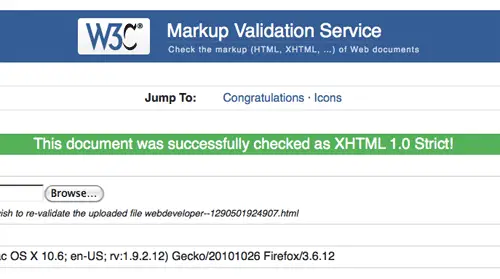Oracle Oaf Exception Details Won t Show Again
Designers spend hours carefully crafting every picayune particular in the design of their website, but the quality of their coding often comes upward brusque. For proof, just wait at the sites showcased in CSS galleries, 90% will accept validation errors – Near of which are easy and simple fixes. Allow's look at some of the nigh common validation errors that announced time and fourth dimension again, and how to correct them to actually cease off your sites with high-quality code.
If it looks OK in the browser, why bother validating? is a common response to validation. Remember that a website isn't all about how information technology looks. An HTML folio is fabricated to present information, not visual graphics, and then this data should be written correctly to ensure it's readable by a wide spectrum of people who employ the web. These people might not be browsing the same as you, instead of seeing the visual website yous've designed in a browser, they might be hearing the site through a screen reader.
An mistake complimentary HTML page is much more likely to be rendered correctly past a range of browsers, and maintain compatibility with future versions. Not to mention the search engine bots for all you lot SEO people – You wouldn't want to put obstacles in their style, a clean and valid page is going to be much easier for the bots to read and browse.
At that place'due south too the aspect of professionalism. I run across invalid HTML little like spelling mistakes, although the client probably won't see a mistake in your code, the idea is even so the same. Yous wouldn't want to supply a blueprint full of typos or spelling errors, and so you lot shouldn't really settle for an HTML page total of little validation issues.
Here'southward a bunch of validation errors that were picked out from sites showcased on the first page of a well known CSS gallery. Many of the sites looked neat, but as y'all can run across, the quality of code just doesn't friction match the quality of the blueprint. The thing is, all of these errors tin can exist easily fixed in minutes.
No Doctype at all
The worst thing you could do validation wise is to forget a Doctype altogether! No Doctype means browsers will have to gauge what language your page is written in. To gear up this fault and all the subsequent issues, add together an HTML or XHTML doctype to your page.
Forgetting to close an element
If you've opened a tag somewhere in your HTML document, you must remember to close it in the appropriate place. Forgetting to do then won't simply invalidate your HTML, information technology might too be the crusade of some serious layout bug. The warning for this in the W3C validator is the cryptic message cease tag for "p" omitted, but OMITTAG NO was specified
– Which basically means Dude, you forget to close that paragraph tag
Missing / on self-closing elements
Most HTML elements have a dissever closing tag, eg: </div>, merely other elements like input, img and meta are self-endmost, this means they take a trailing slash before their closing bracket. Forgetting this is just the same as forgetting a endmost tag altogether.
Forgetting to catechumen special characters
The ampersand is probably the most popular offender here, forth with quotation marks that have been pasted in from Discussion. Always remember to cheque through your trunk copy and catechumen any & signs to the HTML entity &, and all other special characters to their appropriate entity symbol.
Unencoded characters in URLs
Following on from the terminal betoken, special characters, particularly the ampersand should besides be converted to entities when they appear in URLs. Links to sites congenital in PHP are likely to include variables in their links using the & character, and then write these in your HTML using the & entity.
Block elements within inline elements
A cardinal rule of HTML is that cake elements should never go within inline elements. A popular example is an anchor inside a header:
<a href="#"><h3>bananas</h3></a>
The <h3> is a cake chemical element, so it should wrap the anchor (an inline element) like and so:
<h3><a href="#">bananas</a></h3>.
No ALT attribute added to images
Every epitome inserted into your HTML document should have an ALT attribute to describe its contents. If the image is for presentation purposes simply the ALT attribute should still exist but may be left empty, eg: alt="". Otherwise a clear clarification of the image contents should exist provided.
Using attributes like "width" and "height"
This is probably a side upshot of using a WYSIWYG editor which tend to insert HTML that shouldn't really be there. width and height attributes are perfectly fine in Transitional Doctypes, but if yous're aiming for perfection with a Strict Doctype you should know that presentational styling should be saved for the CSS stylesheet.
Starting a class or ID with a number
Course, ID or proper name attributes can't begin with a number. They can include numbers, but not at the start of the discussion.
Unlike HTML, CSS is used just to display the visual aspect of a web page, therefore the statement "If it looks good in the browser, why bother validating?" stands to a certain caste. An invalid CSS document isn't going to have equally much affect as an invalid HTML document, but you should run a validation check just to make certain you haven't made any typos or mistakes in your code. If you lot've used any fancy CSS3 backdrop, these will invalidate your certificate as they're non yet role of the spec, as long every bit you know they're correct they can be ignored.
Source: https://line25.com/articles/10-common-validation-errors-and-how-to-fix-them/











0 Response to "Oracle Oaf Exception Details Won t Show Again"
Post a Comment